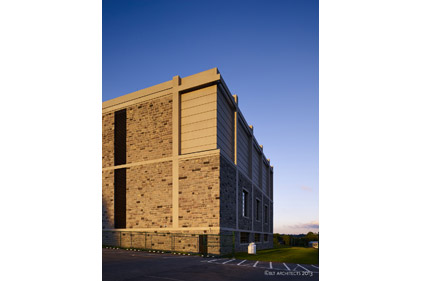
This particular plant was built within the Life Sciences District HABB Quad development, as outlined in the University's 2006 campus master plan. The expansion of the academic campus will include future construction of academic buildings, a structured parking deck and ancillary buildings. The plant is a new component to the University's central chilled water system, and it will serve future on-campus facilities.
Given the chiller plant's gigantic size, the challenge was to devise a way that the building would not overwhelm its future neighboring buildings, and also to have it be aesthetically pleasing. Since 1899, Virginia Tech has built its campus architecture with a regional limestone -- affectionately called "Hokie Stone." In fact, in 2010, the entire board at Virginia Tech passed a resolution that Hokie Stone should be used on all buildings constructed on the University's central campus.
A team from BLT Architects (BLTa) of Philadelphia was called on for their expertise in designing chiller plants. They worked closely with the engineer and University architect to meet the requirements. "The key, obviously, is the brilliant use of Hokie Stone," said Michael Prifti, FAIA, Principal at BLTa. "What is basically a mammoth opaque box fits into context. This will be in the mix of buildings that are coming."
And while the use of Hokie Stone for the design of the chiller plant as well as all campus buildings makes for a beautiful aesthetic, it is also significant to note that the use of regional stone is environmentally friendly. It contributed to the Leadership in Energy and Environmental Design (LEED) Silver certification that was being sought for the building's design. "LEED is also a unique part of the story," said Prifti. "I don't know if there are any campus chiller plants that are LEED. Hokie Stone contributed since it is a local material and high-dollar value. We got exemplary material."
Obviously, Virginia Tech is a unique case in that the school owns a local quarry that is a source of building material. But in this day and age, it is becoming easier to build with the environment in mind. In addition to using stone from a quarry within 500 miles of a project, more and more materials such as ceramic tile and glass products are being manufactured with recycled content. Also in this issue, you can read about StonePeak Ceramics, which recently announced that every tile product that it manufactures is Green Squared Certified. Green Squared, the Tile Council of North America's (TCNA) third party sustainability certification initiative, is set to help revolutionize the North American tile industry as it is the first program of its kind written exclusively for tiles and tile installation materials.
StonePeak is just one of a group of tile manufacturers who are taking the green movement seriously and have had their products Green Squared certified. With companies such as this taking these measures, it will only encourage others to apply for certification of their products as well. And with the amount of green products on the market continually growing, it will only provide more sources for sustainable designs.






